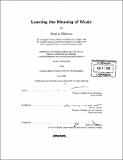| dc.contributor.advisor | Barry L. Vercoe. | en_US |
| dc.contributor.author | Whitman, Brian A. (Brian Alexander) | en_US |
| dc.contributor.other | Massachusetts Institute of Technology. Dept. of Architecture. Program In Media Arts and Sciences | en_US |
| dc.date.accessioned | 2007-12-07T19:20:39Z | |
| dc.date.available | 2007-12-07T19:20:39Z | |
| dc.date.copyright | 2005 | en_US |
| dc.date.issued | 2005 | en_US |
| dc.identifier.uri | http://dspace.mit.edu/handle/1721.1/32500 | en_US |
| dc.identifier.uri | http://hdl.handle.net/1721.1/32500 | |
| dc.description | Thesis (Ph. D.)--Massachusetts Institute of Technology, School of Architecture and Planning, Program in Media Arts and Sciences, 2005. | en_US |
| dc.description | Includes bibliographical references (p. 99-104). | en_US |
| dc.description.abstract | Expression as complex and personal as music is not adequately represented by the signal alone. We define and model meaning in music as the mapping between the acoustic signal and its contextual interpretation - the 'community metadata' based on popularity, description and personal reaction, collected from reviews, usage, and discussion. In this thesis we present a framework for capturing community metadata from free text sources, audio representations general enough to work across domains of music, and a machine learning framework for learning the relationship between the music signals and the contextual reaction iteratively at a large scale. Our work is evaluated and applied as semantic basis functions - meaning classifiers that are used to maximize semantic content in a perceptual signal. This process improves upon statistical methods of rank reduction as it aims to model a community's reaction to perception instead of relationships found in the signal alone. We show increased accuracy of common music retrieval tasks with audio projected through semantic basis functions. We also evaluate our models in a 'query-by-description' task for music, where we predict description and community interpretation of audio. These unbiased learning approaches show superior accuracy in music and multimedia intelligence tasks such as similarity, classification and recommendation. | en_US |
| dc.description.statementofresponsibility | by Brian A. Whitman. | en_US |
| dc.format.extent | 104 p. | en_US |
| dc.language.iso | eng | en_US |
| dc.publisher | Massachusetts Institute of Technology | en_US |
| dc.rights | M.I.T. theses are protected by copyright. They may be viewed from this source for any purpose, but reproduction or distribution in any format is prohibited without written permission. See provided URL for inquiries about permission. | en_US |
| dc.rights.uri | http://dspace.mit.edu/handle/1721.1/32500 | en_US |
| dc.rights.uri | http://dspace.mit.edu/handle/1721.1/7582 | |
| dc.subject | Architecture. Program In Media Arts and Sciences | en_US |
| dc.title | Learning the meaning of music | en_US |
| dc.type | Thesis | en_US |
| dc.description.degree | Ph.D. | en_US |
| dc.contributor.department | Program in Media Arts and Sciences (Massachusetts Institute of Technology) | |
| dc.identifier.oclc | 61896668 | en_US |
